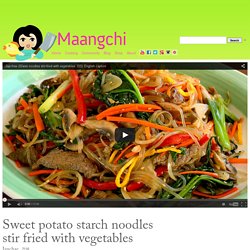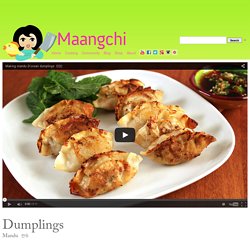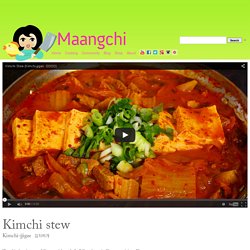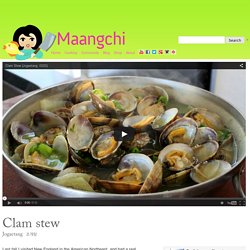

How To Make Miso Soup — Cooking Lessons from The Kitchn. (Image credit: Emma Christensen) Say hello to your newest cold-weather best friend!

Miso soup is that salty, savory broth, dotted with green scallions and silky tofu, served at most Japanese restaurants before the sushi trays arrive. Making it at home is one of the simplest and most satisfying ways to treat yourself during the frigid winter months. Here's how to make miso soup in just a few easy steps. The Secret to Restaurant-Style Miso Soup That elusive flavor that you can't quite name? → Vegetarian Tip: If you're vegetarian, use the kombu in your dashi, but skip the bonito flakes. Making dashi takes just a few minutes — a bit of extra time that's totally worth it for the trade off in flavor. What Kind of Miso? Miso is obviously the central ingredient to making miso soup.
For restaurant-style miso, use red miso made from soybeans. Where to Find Ingredients? Japchae (Glass noodles stir fried with vegetables) recipe. Japchae, sweet potato starch noodles stir fried with vegetables and meat, is one of Korea’s best-loved dishes, and one of the most popular on my website as well.

If anyone asks me to recommend a good potluck dish, I don’t hesitate to answer japchae for the simple reason that pretty much everyone loves it. Mandu (Dumplings) recipe. Ingredients 1 cup of ground pork2 cups of ground beef2 cups of chopped buchu (Asian chives)4-5 soaked Shiitake mushroomshalf onionhalf package of tofu3 cloves of minced garlicsaltsugarsesame oilvegetable oilfish sauceegggreen onionmandu skins (60 discs) Make filling: Place 1 cup of ground pork and 2 cups of ground beef into a big bowl.Add 1 ts of salt, 1 tbs of sesame oil, ½ ts of ground pepper and mix it by hand and push the mixture of meat on the side of the bowl.Wash some Asian chives (buchu), and dry well with a paper towel or cotton cloth.

Chop them into 2 cups’ worth of chives. Add 1 tbs of oil and mix it up. Now we’re ready to make mandu. Put some of the filling mixture into the center of a mandu skin.Use your fingertips to apply a little cold water to one edge of the skin. Butternut squash porridge (Hobakjuk) recipe. The recipe for Hobakjuk needs only a few ingredients.

But making the small rice cake balls takes some time. I recommend you make the rice cake balls with your family members or friends together. Whenever I make this porridge, I remember my grandmother and my family members. We all made the rice cake balls together. Braised chicken with vegetables (Dakjjim) recipe. Dakjjim is braised chicken with vegetables.

Dak (닭) is chicken and jjim (찜) is a cooking term for “braise” or “steam.” So dakjjim is also called jjimdak. There are a few different versions of jjimdak in Korean cuisine, depending on the region it comes from and the ingredients used. The popular Andong jjimdak is a special dish from the city of Andong. This dakjjim recipe that I’m introducing to you today is Andong style, which so many people have requested. Ingredients for 4 servings. Doenjang-jjigae (Fermented soybean paste and vegetable stew) recipe. Kimchi stew (Kimchi-jjigae) recipe. Kimchi stew is one of the most-loved of all the stews in Korean cuisine.

It’s a warm, hearty, spicy, savory, delicious dish that pretty much everyone loves. As long as they can handle spicy food, I never met a person who didn’t like kimchi-jjigae. I learned this recipe from a restaurant famous for kimchi-jjigae in Korea. The restaurant was always full of people eating and sweating over kimchi stew. There was only one item on the menu, so everyone was there for the same thing: a steaming pot of spicy kimchi-jjigae, a few side dishes, and a bowl of warm rice. What really made an impression on me at the time was the fact that they brought the stew out to the table uncooked, and then fired up a burner and cooked it at the table.
Korean Bapsang. Recipes - Cooking Korean food with Maangchi. Rice "Bap" (20 recipes) Rice is at the center of every Korean meal, with very few exceptions.

These recipes express the variety and beauty of the most important grain in Korean cuisine. Traditional napa cabbage kimchi (Tongbaechu-kimchi) recipe. Hello everybody!

Today I’m going to show you how to make classic, spicy, traditional napa cabbage kimchi called tongbaechu-kimchi, a.k.a. baechu-kimchi or pogi-kimchi. Spicy soft tofu stew with kimchi and pork belly recipe. It’s about time for some sizzling, comforting stew, isn’t it?

How about sundubu-jjigae? It’s hot, spicy, filling, comforting, delicious, soft tofu stew and has many reasons to be one of the most popular items in Korean restaurants. I made a video and recipe for sundubu-jjigae seven years ago (!) And it’s been watched over a million times on YouTube (!!). So it was about time for an HD remake and a variation on the recipe, too. This recipe serves 1 or two people, but you can double or triple the recipe for more people, and use a large stainless steel or cast iron pot for the cooking. Clam stew (Jogaetang) recipe. Last fall I visited New England in the American Northeast, and had a real seafood journey!

I tasted many of their local specialties in restaurants, things like clam chowder, lobster roll, and fried clams. Bok choy seasoned with soybean paste (Cheonggyeongchae doenjang-muchim) recipe. Today I’m going to show you a simple and authentic Korean side dish made with bok choy. Bok choy is easily available at many grocery stores in the USA, although in Korea I would use napa cabbage or sweet potato stems instead. When bok choy is blanched and then seasoned with this tremendously delicious seasoning mix, it’s soft, juicy, a little cripsy, and takes on a sweet, salty, pungent doenjang flavor.